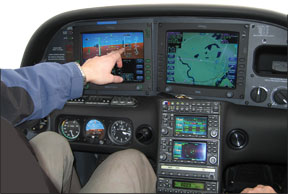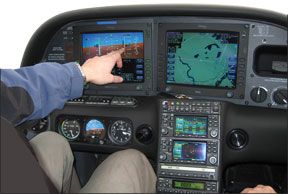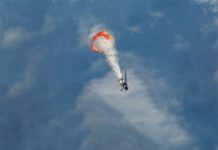Last month we looked at buys on late-model, four-seat singles (“Late-Model Cruisers: Cessna, Cirrus Are Tops,” Aviation Consumer March 2009) and were shocked at how many good deals there were on used aircraft with glass cockpits.
How about a 1300-hour 2005 Cessna 172SP with a G1000 and autopilot for $157,000? We found similarly-equipped 2005 and 2004 Diamond DA40s with about 1000 hours on them for $165,000 and $159,000, respectively. Tipping the scales a bit further was a well-kept 2003 Cirrus SR22 with 1251 hours, TKS de-ice, Skywatch, Stormscope, XM-weather, digital charts, TAWS and the latest revision of the PFD software for $210,000.

Looking up the food chain to Mooneys, Columbias, Barons and the like, the deals are less dramatic, but they are still huge discounts from the new prices for relatively low-time aircraft. A good example is the 165-hour 2006 Mooney Ovation 2 with a G1000, known ice and most every option for $350,000.
With the economy pulling the rug out from more and more people, repossessed aircraft are hitting the market as well. Were even seeing still-new 2007 models that have been wallflowers waiting for an owner with their sticker price sinking lower and lower.
The Glass-Cockpit Trap
For those with cash available, this is a great time to acquire a glass-cockpit aircraft. But there is a dark side to this rosy picture. Glass panels are far from maintenance free. Two seemingly identical models of an aircraft might have significantly different software versions loaded, have different optional (or even mandatory) service bulletins complied with and even different parts installed.
The fallout from all this is that saying an aircraft has a G1000 isn’t like saying it has a KLN 90 GPS. As a buyer must know the exact status of that system before paying up, because it could have a large impact in the bottom-line value of the aircraft.
The headaches can happen even outside the panel. Aircraft delivered with G1000s have system software loaded onto a CD-ROM thats technically part of the aircraft flight manual. If the software has to be reloaded, its transferred to SD card from these CDs. This happens more than you might think as files can become corrupt. The software is also reloaded when replacing some G1000 components or LRUs. Garmin and the aircraft manufacturer can provide replacement software if needed without much hassle, but if you break down on a trip and the shop needs to load the software, you’ll save much time by having the disks with the aircraft.
A more critical, and potentially costly, issue relates to G1000 optional features such as electronic charts. These options are unlocked with an SD card that only works with the unit for which it was originally activated. When maintenance is done, the unit may ask for this card. don’t have it? Thatll be $3100 for a new unlock card, thank you. TAWS, terrain and synthetic-vision options work in a similar fashion. We heard from one owner who spent days tracking down these items after his aircraft had been hit by lightning on the ramp. No major damage to the plane, but all the software needed to be reloaded. In short, don’t take delivery of the aircraft unless you have all the original media in hand.
Our research turned up 15 G1000-related optional and mandatory service bulletins on late-model Cessnas. Those optional ones can matter. One of the SBs for the autopilot servos of the KAP140 autopilot was optional, so some owners didnt comply. These servos are now failing at an accelerated rate. Honeywell usually has a decent supply of servos for exchange and support is normally good, but when the equipment is out of warranty the $1500 servo is on your tab.
Another issue exists with 2004 Cessnas that were shipped without the GDL69 datalink receiver. These were later installed in the field, and there have been reports of poor installs causing intermittent XM weather reception-a problem thats hard to troubleshoot if you don’t know where to look.
A seemingly small upgrade might have big returns. S-TECs $4000 roll-servo upgrade for Cirrus SR22s removes some autopilot restrictions and, S-TEC claims, improves the autopilot performance. The stock SR22 uses the trim motor for autopilot roll control, which wears out the motor faster than one would hope. The roll-servo upgrade may put off a trim motor replacement.
Upgrade it? Not So Fast
There’s a temptation to look at the low prices for older glass-cockpit aircraft and figure in an upgrade as part of the cost. This may be a logical move, but it has limitations.
For instance, we know a proud new owner of an earlier Cirrus SR20 with Avidyne Entegra PFD/MFD suite and pre-WAAS Garmin GNS 430 navigators. He had planned for Garmins flat-rate WAAS upgrade cost of $3000 per unit. He was a bit surprised with the installation labor to replace the GPS antennas, but the real shocker was when he discovered that his Avidyne Entegra PFD had to be upgraded to Release 7-a major mod that adds PFD features and reliability as we’ll as making it WAAS-ready. The upgrade requires removal of the PFD and a $4000 trip to the factory, plus labor, calibration and paperwork. The final bill for WAAS was north of $10,000.
That 10 grand could be an easy bargaining point when closing the deal, but not after you fly it away. The market is loaded with G2 SR22s never upgraded to WAAS, traffic or terrain awareness. One Archer owner we spoke with looked at his current mount with a GNS 530W (WAAS) and TIS traffic, and decided the tempting Cirrus wasnt worth it given the asking price plus upgrade.
WAAS upgrades to the Garmin G1000 hold fewer surprises but are guaranteed to be just as expensive. In the Garmin setup, WAAS-
equipage means replacing the two GIA63s-the module that contains a GPS engine, Nav and Comm radio and other functions-and swapping it for the new GIA63W. The logistics for the mod differ among aircraft manufacturers, but for the Cessna the parts alone are over $15,000 even after a $3500 rebate. There’s up to 11.5 hours of shop labor involved. You also might have to bring the aircraft to an approved type service center (rather than your regular avionics shop) for the upgrade.
Several owners of various makes with the G1000/KAP140 autopilot combinations did this upgrade and had a nasty surprise. After investing the new system, the aircraft stubbornly refused to fly coupled approaches following a GPS-derived glidepath, even though it flew ILS glideslopes just fine. As one owner told us, “I was so pissed off about it I ended up buying a 2007 model.”
Maybe thats good for Cessna, but not for you. It turns out the stickler is that Honeywell wont approve the KAP140 in OEM installations with more than one glideslope source. Word is that Honeywell has no plans to fix this, even though the KAP140 can fly fully-coupled, GPS approaches with other navigators such as the GNS 430. Sounds like an STC opportunity to us.
Tips for Buying Glass
All this shouldnt dissuade you from snatching up a good buy on a used glass cockpit. There’s just more homework than buyers might think.
The first step is knowing exactly what you want and when it became available. For example, the G1000 was introduced for the Cessna 182 in 2004 with only small changes in the model line for the next two years. Any of these aircraft can be upgraded to WAAS and synthetic vision (but they wont fly fully-coupled GPS approaches). Yet there’s about a $30,000 premium for each newer year, regardless of total time on the airframe. Finding a babied 2004 will leave you without the improved pedestal lighting, but could save you enough for a WAAS upgrade.
The integrated Garmin autopilot and WAAS both hit the Cessna 182 in 2007, but some of the early serial numbers had a combined antenna that makes the aircraft ineligible for GPS, sole-source navigation. This is more a legality than a practical problem, but it illustrates the point of doing your research.
When youve found your baby, you’ll want to do an avionics pre-buy (see sidebar opposite page) in addition to normal checks of compression and inspections. If the aircraft still has remaining warranty, make sure all that documentation is in order. Out-of-warranty costs can be quite high for this equipment.
Everyone needs to be realistic in this market. Several brokers have told us about what should have been good agreements that went south because the buyer, feeling empowered by the down market, just ticked off the seller with an offer as low as 50 cents on the dollar. This phenomenon may be part of why one broker told us that few aircraft are selling. Out of several aircraft hed been watching for the past five months, 90 percent were still on the market.
If youre thinking of trading into a Cirrus, you might check out Cirrus certified, preowned program and have Cirrus broker your existing ride. Offloading a steam gauge model is difficult in the current market. Cirrus will travel to your home field for a demo ride. As one buyer put it, “The experience was similar to buying a pre-owned BMW.”
Finally, don’t forget to budget in the cost of updates and subscriptions. Everyone thinks about the GPS approach database, but people often forget obstacle databases or XM weather subscriptions that can tack on another $1500 a year or more, depending on how current you choose to keep them.
The glass panel story doesnt end with OEM glass, either. We saw a low-time 2000 Piper Archer with the Aspen Avionics PFD, dual GNS 430Ws, an S-TEC 55X autopilot and several other extras for $185,000. we’ll look at buying older and creating your own glass cockpit in a future issue. But if youre objective is an OEM glass cockpit, now is a good time to take the plunge.





